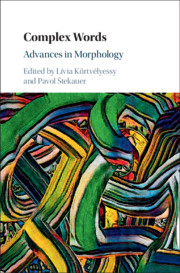Book contents
- Complex Words
- Complex Words
- Copyright page
- Dedication
- Contents
- Contributors
- Introduction: Advances in Morphology
- Part I Lexico-Semantic Aspects of Complex Words
- 1 Formal Semantics and the Problem of Nominalizations
- 2 Semantically Subtractive Morphology
- 3 -less and -free
- 4 Instrument Nouns in -one in Latin and Romance
- 5 Prominence in Noun-to-Verb Conversion
- 6 On Spanish Dvandva and Its Restrictions
- Part II Structure of Complex Words
- Part III Corpus-Based Case Studies
- Index
- References
1 - Formal Semantics and the Problem of Nominalizations
from Part I - Lexico-Semantic Aspects of Complex Words
Published online by Cambridge University Press: 18 September 2020
- Complex Words
- Complex Words
- Copyright page
- Dedication
- Contents
- Contributors
- Introduction: Advances in Morphology
- Part I Lexico-Semantic Aspects of Complex Words
- 1 Formal Semantics and the Problem of Nominalizations
- 2 Semantically Subtractive Morphology
- 3 -less and -free
- 4 Instrument Nouns in -one in Latin and Romance
- 5 Prominence in Noun-to-Verb Conversion
- 6 On Spanish Dvandva and Its Restrictions
- Part II Structure of Complex Words
- Part III Corpus-Based Case Studies
- Index
- References
Summary
This paper discusses the ways in which formal or model theoretic semantics has difficulty addressing questions of lexical semantics, specifically questions that arise in accounting for the pervasive polysemy of deverbal nominalizations like German Bemalung (painting) and English blending. Formal or model theoretic semantics has largely neglected issues in which analysis of complex words comes to the fore. I briefly review the history of model theoretic semantics and its relation to lexical semantics and illustrate the tendency for conceptual semantics to be quietly integrated into referential semantics, as, for example, in a recent article by Pross (2019). I conclude with a brief sketch of how Lieber’s (2004, 2016) Lexical Semantic Framework treats the polysemy of deverbal nominalizations.
Keywords
- Type
- Chapter
- Information
- Complex WordsAdvances in Morphology, pp. 19 - 35Publisher: Cambridge University PressPrint publication year: 2020



